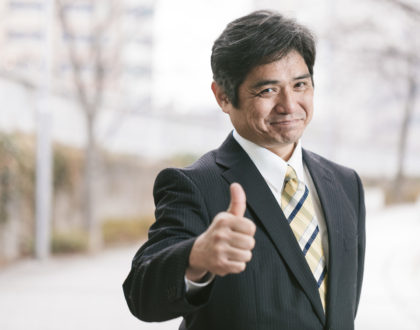5 Pillars of Japanese Manners

by Madelaine
There is no shortage of behavioral rules in Japan. While Japanese manners are strict, especially when dealing with customers, they are not as scary as it first seems.
All it takes are 5 basic rules to keep in mind.
コンテンツ
Why the strict manners?
Rules about dealing with customers are so standardized that Japanese manner guides often summarize them as the “5 basic principles” – appearance, greetings, attitude, word choice, and expression.
But why the need to corset everything in such a strict system of behavior rules?
First impressions are everything. Nobody wants to endanger a deal just because of some minor aspect that could start an encounter on the wrong foot.
Structure gives security. Having interactions follow a certain pattern and order that every participant is aware of makes communication go more smoothly.
What may bring the average Japanese employee more security can be a nerve-wracking array of pitfalls for foreigners.
But fear not! That’s exactly what the 5 basic rules are for. Just follow these fairly simple guidelines and you are on your best way to win over even cold-hearted Japanese businessmen.
Appearance
The first aspect of Japanese manners, or business manners in general is appearance (身だしなみ, みだしなみ in Japanese). No matter which country in the world, everywhere a neat appearance is expected when dealing with business partners.
More precisely, for Japanese people, a good appearance meets the following criteria.
✔ Cleanliness
✔ Appropriateness
✔ Functionality
And there is a good reason for it: over 50% of your first impression is decided by how you look!
Of course, looks aren’t everything but imagine this. The person you just met cannot help but stare at the loose button or the bed hair you forgot to tame in the morning. In the best case, they won’t focus on what you say, in the worst case, it may reflect badly on your character.
So, take a minute to choose your outfit in the morning and risk a look in the mirror before an important meeting.
Greetings
Greetings (挨拶, あいさつ) are big in Japan and consists of the verbal greeting as well as the bow.
While respectful Japanese has a lot of variations on greetings, it all boils down to four basic phrases known as オアシス.
オ おはようございます – Hello.
ア ありがとうございます – Thank you.
シ 失礼します – Excuse me.
ス すみません – I’m sorry.
Not too hard, right?
Many companies even drill their recruits in proper greetings.
The key to a great Japanese-style greeting are a friendly smile and a loud and clear voice.
Attitude
The next one can be a little tricky. After all, your attitude (態度, たいど) is not immune to outside influences and people have different pet peeves.
While there are always people we click with better than others, the key is having a professional attitude at all times.
Behavior and gestures (立ち居振る舞い, たちい ふるまい or 仕草, しぐさ)
Are you listening closely or are your eyes wandering off while you’re tapping your foot thinking about the weekend? A professional attitude means paying attention to the other person and behaving respectfully.
Common sense, right?
Also, pay attention to how you do things – it shows respect for the other person.
For example, when handing over documents
✔ Use both hands
✔ Make eye contact
✔ Have them face up
Energetically ‘dropping’ the documents on the table may be perceived as you carelessly throwing things around and thus rude.
Posture (姿勢, しせい)
While Japanese rules can fussy about where one should sit in a room etc., the how is much more straightforward. Having the right posture will help you seem attentive, even if your mind does wander off sometimes.
So, sit/stand up straight, relax your shoulders, don’t cross your legs and keep your shoes on even when you think nobody can see.
In short, just don’t get too comfy.
Expression
The above only really works if you combine it with the right facial expression.
Imagine someone thinking up straight in his chair staring at you with an expressionless face. How does that make you feel?
Eye contact (視線, しせん): Facing someone directly and maintain eye contact signals interest and attention. That’s good, but you also need something else.
Smile (笑顔, えがお): A simple smile can make someone like you or help to gain their trust. The Japanese know that and are masters’ at smiling (if they want to).
Cheerfulness (明るさ, あかるさ): Being friendly, optimistic and just generally fun to be around isn’t only good with friends. You can use the same positive energy to strengthen work relationships.
Your voice is another tool at your disposal. On the phone, you can often notice Japanese people speak in higher-pitched voices than normal. Regardless of gender or age a high voice is generally perceived as friendlier so use it to your advantage.
What all this comes down to is that paying attention and being friendly gives the other person the feeling that you care about them. Which will not only impact how they think of you in return but also makes them more likely to want to work with you.
This doesn’t mean you should force yourself or act unnaturally.
Instead, focus on making the other person feel welcome.
Word Choice
Once you got all else down, there is one final layer before coming to the actual content of the conversation. Polite Speech.
The main three areas are:
✔ Respectful Speech (敬語, けいご)
✔ Phone Calls (電話対応, でんわたいおう)
✔ Dealing with Customer (来客対応, らいきゃくたいおう)
Getting this down can take some time because let’s be honest, business Japanese is complicated.
But you don’t have to be perfect from the get-go (personally I aim for ‘decent’ as my long-term goal).
The trick is to get a grip on the basics and go from there. Most Japanese people will be understanding of the fact that this is not your native language as long as they can see that you are trying.
Essential Phrases
Even if you just started learning Japanese by mastering just a handful of phrases you are ready to take on any situation coming your way.
These essential terms are called 接客7大用語. Depending on who you ask sometimes one term is added to the list.
1. いらっしゃいませ
Greeting the customer, especially at a store. In a business setting substitute this one for a こんにちは or another appropriate greeting.
2. お待たせいたしました
Use this when you asked someone to wait or arrive late. You made someone wait a long time? Add 大変 at the beginning.
3. かしこまりました
Meaning ‘certainly’ or ‘understood’ use this phrase when someone is giving you a task or requesting something from you. (Unless of course, you cannot do it.)
4. 少々お待ちください(ませ)
No clue what to do? Use this phrase to gain some time to get help or look for information. Don’t forget to use nr.2 when getting back to your customer.
5. 申し訳ありません(ございません)
Made a mistake? It doesn’t have to become a big deal as long as you apologize directly. Important is to also show your sincerity in your expression, a bow is also appropriate.
6. 恐れ入ります
When asking someone to do something this word comes in handy. It shows the other party that you are aware that it might be an inconvenience to them or that you are simply considerate of and valuing their time.
7. ありがとうございます(ました)
Never forget to express gratitude. Whether someone did you a favor, you received an order, or feedback from someone, the opportunities to connect over a ‘thank you’ are plentiful.
8. 失礼致します
Entering or leaving a room, etc. When it’s not something to be sorry for but you still want to express that your actions may cause discomfort or inconvenience to others around you.
Do you dream of working in Japan?
Don’t wait until your Japanese is ‘good enough’.
Job-hunt while learning Japanese! Business Japanese School in Tokyo
Recommended Posts

How to Get Along with Your Japanese Boss
25 5月 2021 - Work, Working Culture

The 10 Most Popular Japanese Companies in 2021
19 5月 2021 - Work

